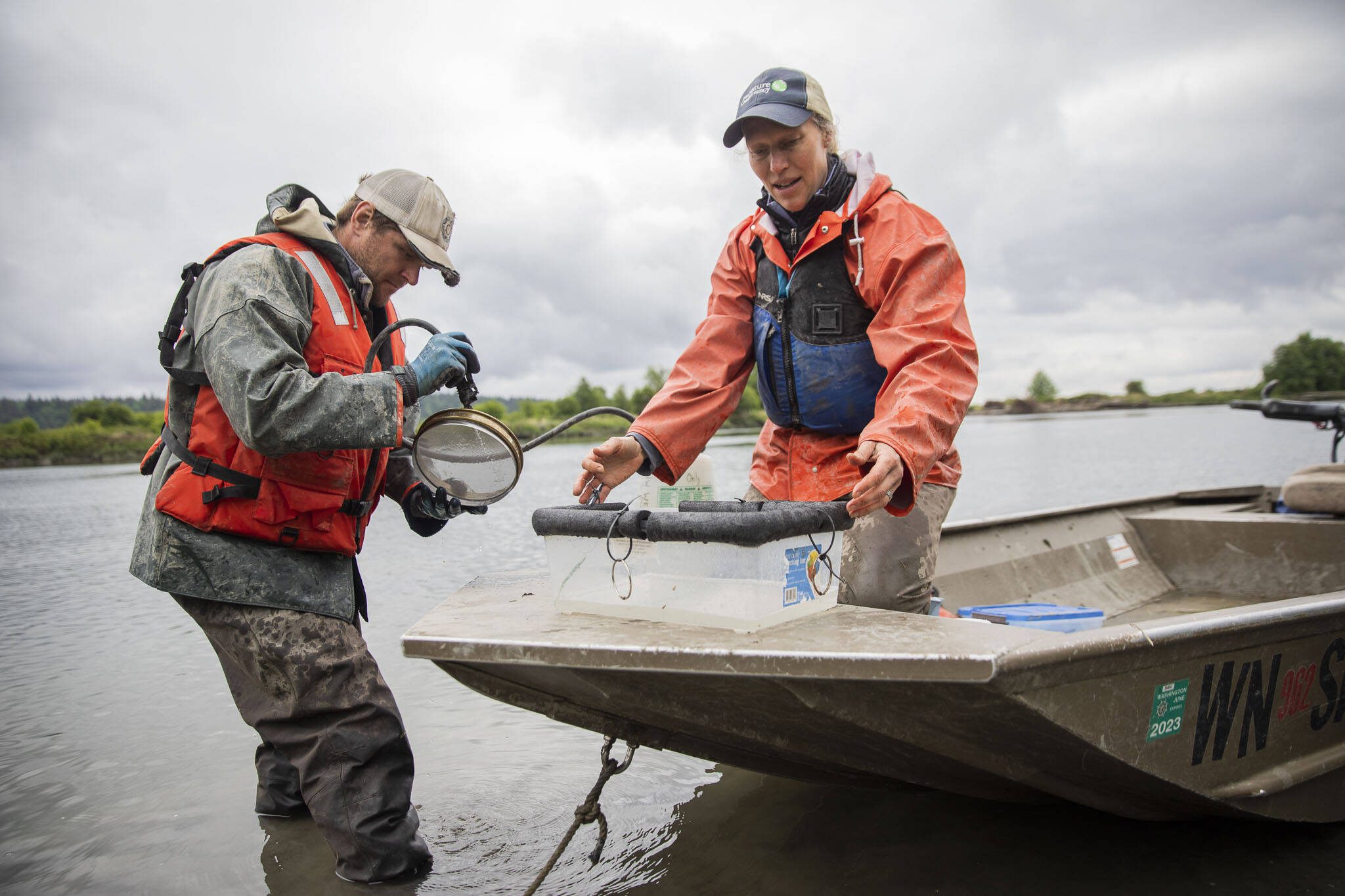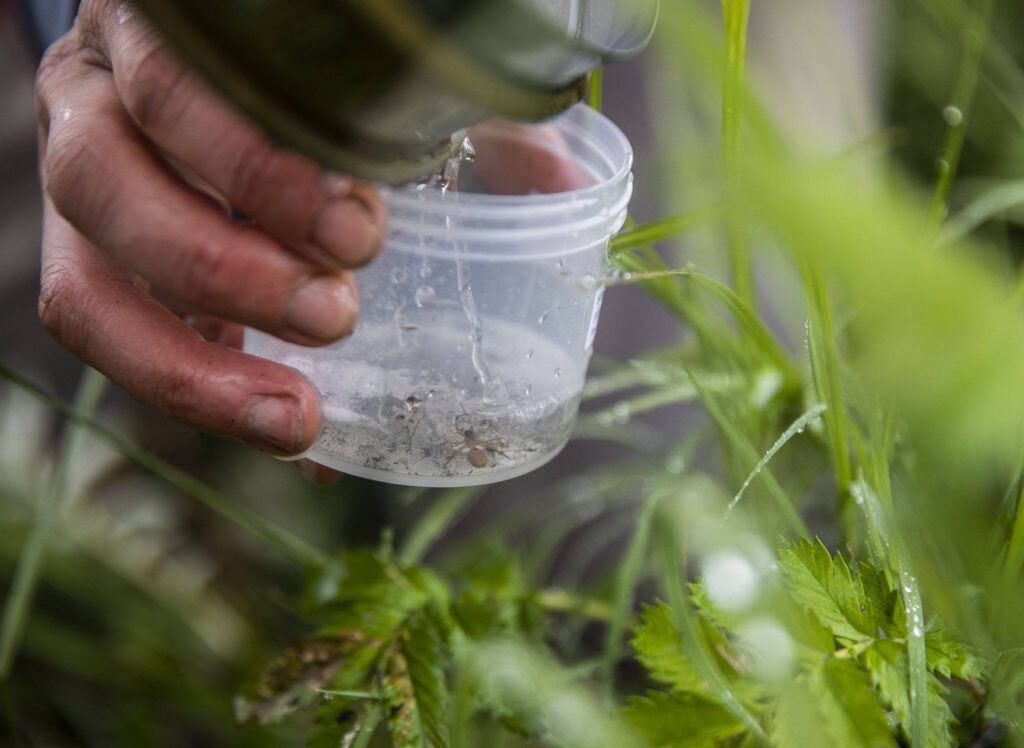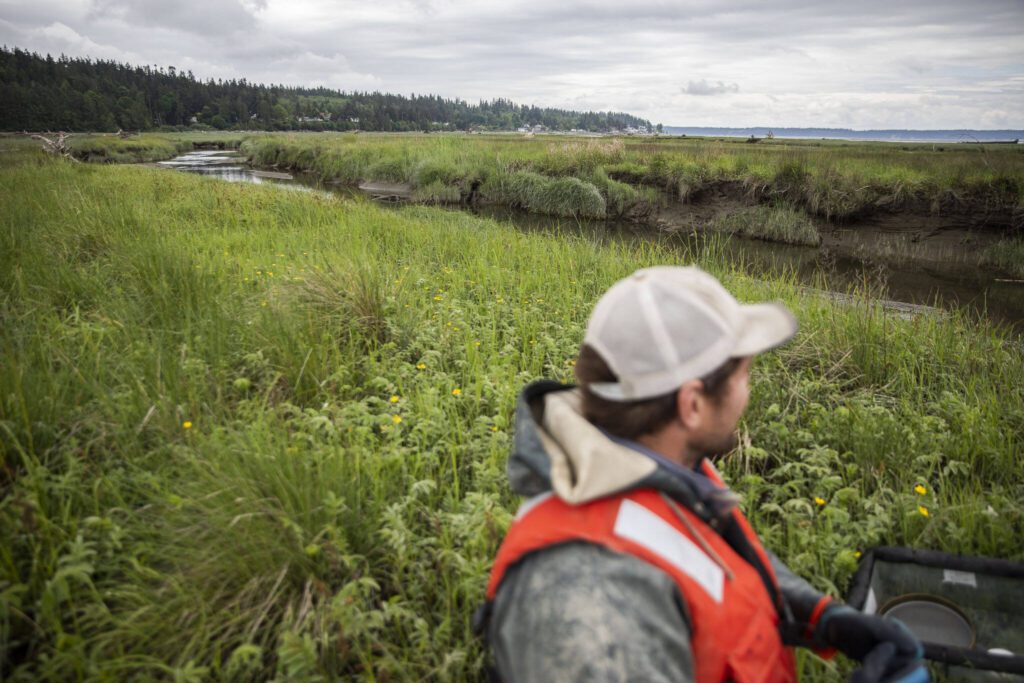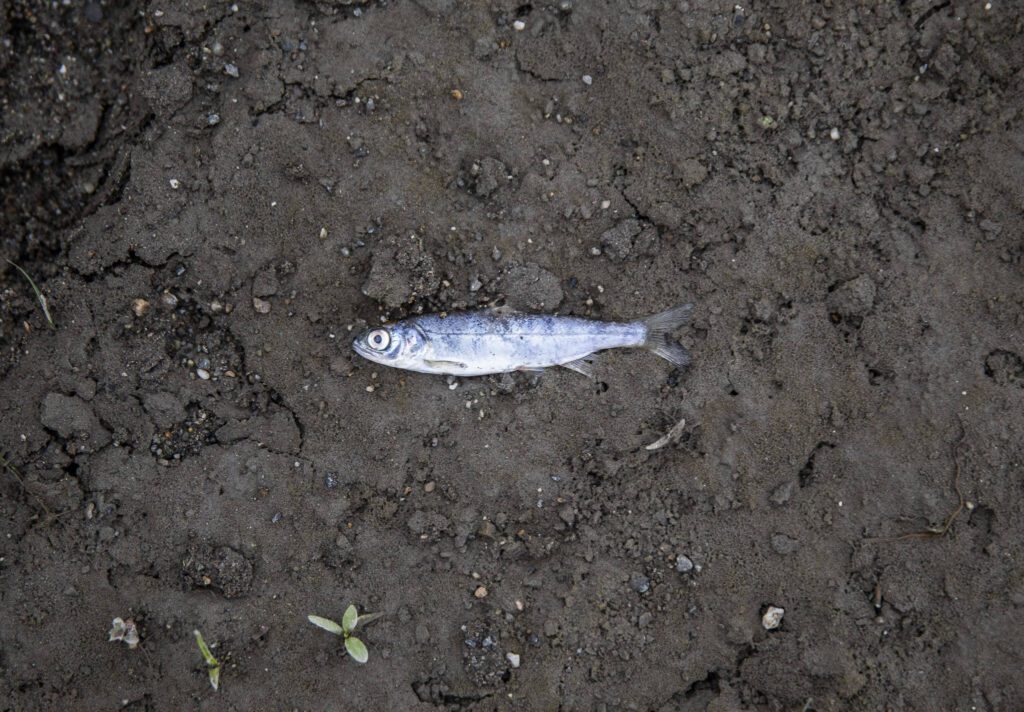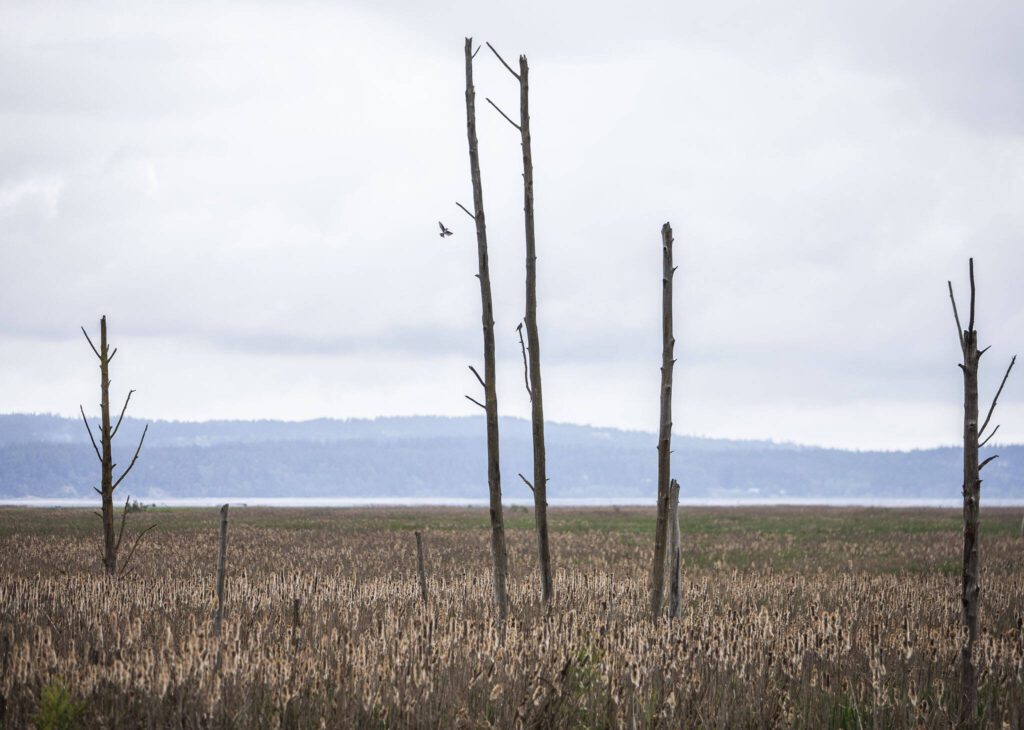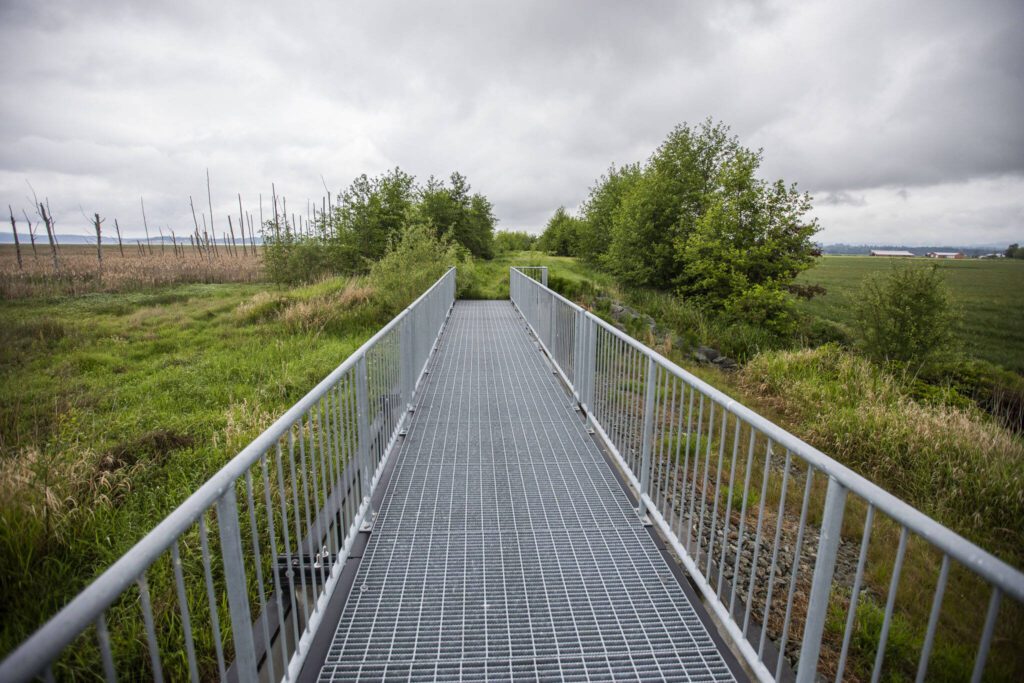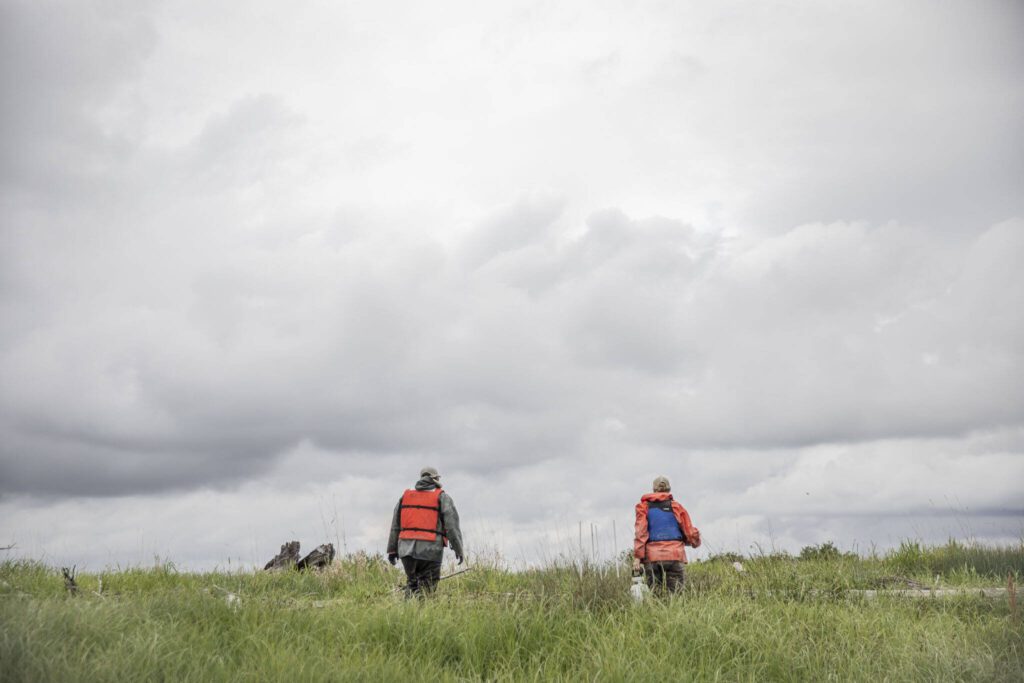STANWOOD — On a cold May morning, Emily Howe loaded into a small motorboat to revisit her bug sample sites in the Port Susan Preserve.
Small flies and other aquatic bugs are a major food source for salmon. In the Stillaguamish River tidal estuary, where freshwater meets saltwater, those bugs are food for salmon.
“We’re trying to build a delta for the future,” said Howe, 44, is an aquatic ecologist with the Nature Conservancy. “Assuming we can make more fish upstream, and the ocean can keep making fish, we want to make sure that we can build an estuary that can handle and support all of those fish — even if those fish aren’t here right now.”
Around 20,000 salmon, historically, were supported by the south fork of the Stillaguamish River, which flows to Port Susan Bay. In 2019, fewer than 500 fish returned to spawn, according to a Nature Conservancy fact sheet.
This makes their main food source — tiny bugs — a big deal for the conservancy, as well as for a cohort of nonprofits and government entities dedicated to saving five species of salmon native to the watershed.
The Nature Conservancy was awarded $799,000 for the latest phase of its work at Port Susan, as part of $24 million federal grant for Whidbey Basin projects. The basin accounted for 70% of the historic tidal habitat surrounding Puget Sound.
In 2012, the Nature Conservancy removed levees, flooding old farmland south of Stanwood. Restoration and monitoring work has continued since.
The section Howe sampled on this day is a 150-acre “footprint” in 4,100 acres the Nature Conservancy owns in the floodplain. The property was originally bought by the conservation group in 2001.
This time, Howe and Henrichs were looking at calorie-dense bugs near the shore. All of this becomes valuable data for protecting the estuary.
‘What we’re fishing for’
Decked out in waders and lifejackets, Brian Henrichs steered the boat to a number of bug traps over a period of three hours: near the boat ramp, where the shores are rocky and trees line the banks, then farther in the grassy low-lining tidal plain.
A clear day, it was a smooth ride out to the traps as Henrichs, 35, expertly guided the skiff. Rocks and trees that provide habitat for salmon fry are not up for removal. So the estuary is like an obstacle course — and that makes it a fun day at the office.
In the summer, when the estuary is warm and buzzing with life, they will monitor larger aquatic wildlife by fishing them up with nets. Salmon are the primary target, but anything swimming in the delta is valuable to know about. Occasionally, they attract the attention of passersby.
“We do get a lot of people asking what we’re fishing for,” Henrichs said. “It’s like, ‘Well, everything, and don’t get so excited.’”
On this day, though, no nets were in sight. One dead salmon had washed up on a sandbar near one of the bug traps. Flies do well in habitats containing native flora. In a trap near one native bulrush, the crew found a great deposit of bugs.
The traps are simple: small plastic containers filled with a mix of dish soap and water, left overnight and collected the next day.
“I’m really sorry for the graduate students we’re hiring,” Howe said. “They have to go through those nasty samples.”
Take one near the boat ramp, for example. It contained a handful of black flies. Howe and Henrichs surmised they likely came from a field across the way where a farmer had recently manured the crops.
That’s a stark difference to further down the estuary, where an old dike separates Nature Conservancy property from the Stillaguamish Tribe’s zis a ba II project. Soon, the dike between the two properties will be torn down.
The Stillaguamish Tribe received $3 million from the recent federal grant for the zis a ba project, as well as two others. The zis a ba II project will restore 230 acres of tidal marsh bordering Nature Conservancy owned land.
Once the dikes are removed, the farmland will become protected tidal marsh. The hope is that, eventually, these swaths become a dependable place for young salmon to thrive.
‘Greatest conservation need’
Howe and Henrichs are part of a large team dedicated to monitoring the Port Susan Bay estuary.
Salmon are culturally important to the Stillaguamish and other nearby tribes, an emphasis for groups working in the Whidbey Basin.
The fish are a major food source for orcas — another culturally important animal — and are harvested as human food as well. Salmon do not seem to mind where their marshy tidal habitat to grow up in is, only that is suitable, Howe said.
“It’s the 11th year of monitoring that site, which is wild, but we’re keeping that up to continue the long-term data set to see how the next phase of restoration influences vegetation composition,” said Molly Bogeberg, a marine conservation manager with the Nature Conservancy, in a interview.
Fauna tracking is fairly simple. A grid is made out of tape. They identify plant species in the grid. Using the “transect lines,” biologists can calculate plant density and diversity.
Near the boat ramp, shoreline foliage contains a number of water-loving trees as well as dense bushes. Closer to the sound, dense grasses and bulrushes cover the riverbanks.
Much of this has to do with saliency, or how much salt is in the water. Some plants can tolerate more brackish water. Researchers dig holes and once they fill with water — because it is, after all, a marsh — they take salinity samples.
Shoreline trees cool nearby waters. And fish need cold water.
The Port Susan site is also located within the Pacific Flyway, a common migratory route for a billion birds. The Puget Sound Bird Observatory, in contract with Nature Conservancy, uses volunteers to track birds in the estuary.
Similar to foliage monitoring, a grid helps to track avian diversity.
Amber Parmenter, a Port Susan Bay steward with Nature Conservancy, oversees bird monitoring at the site, among other duties. She said the area supports a population of western North American purple martins, a “species of greatest conservation need.”
Puget Sound Bird Observatory members are “out there every season keeping track of the birds on site,” Parmenter said. “I’m kind of jealous now, they know a lot more about what’s going on.”
‘Think like a fish’
As Henrichs maneuvered the boat along the main stem of the Stilly, he pointed out different channels.
It’s hard, he said, to fully explain what the channels need to look like to the contractors building them. Ecological engineering and restoration is still a fairly new field.
“They’re used to building canal,” Henrichs said. “When they hear channel, they think canal.”
Both Henrichs and Howe were quick to say they’re not criticizing the contractors. It’s just complicated.
For starters, driving large tracked vehicles into the marsh is not easy. Few construction companies have amphibious heavy equipment in their yard. It is also difficult to get any machinery into muddy wetlands. Over the years, heavy farm equipment packed down the marsh to the point where it was lower than surrounding soil. Heavy vehicles push down the soil even more, something the Nature Conservancy ran into with the project.
Clay hardened by vehicle pressure has to be broken up. Channels need to be at different depths so a number of creatures, throughout their life cycle, can use them. Work on the estuary does not end when a levee is pulled down. It has to be monitored so future work can be effective.
“We’re getting closer to being able to think like a fish,” Howe said.
In lieu of packing down the marsh more, the Nature Conservancy has explored dynamite as a low-impact alternative — as hard as that may be to believe.
“So we tested out that method last summer. It took us two years to get the permit to do it, but we had a team come out to blast a 100-foot linear channel to test that method,” Bogeberg said. “We thought it went really well and it does actually reduce the impact to the marsh, because you don’t have any equipment coming out, you just have people on foot.”
‘Apathy is dangerous’
Wildlife protection is a field where it can be difficult to stay positive.
“I think I get sad a lot about the state of where we’re living and where we’re working,” Parmenter said. “But there are some things that help. I think that apathy is dangerous. And I don’t want to be in that state where I just have completely given up and don’t think there’s any reason to do the work that we’re doing. I think it’s really important.”
Habitat loss is one threat to salmon, but chemicals from cars have also been linked to reduced populations of coho salmon. Firefighting retardant used on wildfires is another pernicious pollutant. Overfishing and lack of appropriate food are all major threats. Climate change is killing salmon too.
Once they’re large enough to be in the ocean, they can survive, but getting them to that point is the heart of nearly ever Whidbey Basin project.
“If you don’t have enough spawning ground, even if you do have enough fish coming back, they can’t spawn,” Henrichs said. “But if you do and they don’t have enough up river rearing habitat, they get pushed out of the river and come to the estuary. If they don’t have enough estuary habitat, they get pushed to nearshore. If they get into nearshore habitat, they get pushed out into the ocean and die.”
For people like Howe, who has worked within the Port Susan Bay area for over two decades, saving salmon has become a lifelong obsession.
Standing on the dike separating Nature Conservancy and tribal land, she pointed first at the zis a ba project, then a field closer to a channel that had gone back to a more natural state.
“Soon,” Howe said, “that will look like this.”
Jordan Hansen: 425-339-3046; jordan.hansen@heraldnet.com; Twitter: @jordyhansen.
Talk to us
> Give us your news tips.
> Send us a letter to the editor.
> More Herald contact information.
